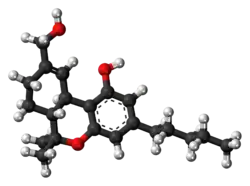11-Hydroxy-THC
 | |
 | |
| Identifiers | |
|---|---|
IUPAC name
| |
| CAS Number | |
| PubChem CID | |
| ChemSpider | |
| UNII | |
| CompTox Dashboard (EPA) | |
| ECHA InfoCard | 100.164.583 |
| Chemical and physical data | |
| Formula | C21H30O3 |
| Molar mass | 330.468 g·mol−1 |
| 3D model (JSmol) | |
SMILES
| |
InChI
| |
| | |
11-Hydroxy-Δ9-tetrahydrocannabinol (11-OH-Δ9-THC, alternatively numbered as 7-OH-Δ1-THC), usually referred to as 11-hydroxy-THC, is the main active metabolite of tetrahydrocannabinol (THC), which is formed in the body after decarboxylated cannabis is consumed.[1][2]
Fresh cannabis contains tetrahydrocannabinolic acid (THCA), which is converted into THC after heating and then metabolized by the body into 11-hydroxy-THC and then into 11-nor-9-carboxy-THC;[2] both compounds can be glucuronidated and mainly excreted into urine. Both compounds, along with THC, are assayed in blood tests.[1]
11-hydroxy-THC has a comparable psychoactive effect to THC, but with a faster onset of effect.[3]
See also
References
- 1 2 Kraemer T, Paul LD (August 2007). "Bioanalytical procedures for determination of drugs of abuse in blood". Analytical and Bioanalytical Chemistry. 388 (7): 1415–35. doi:10.1007/s00216-007-1271-6. PMID 17468860. S2CID 32917584.
- 1 2 Huestis MA (2005). "Pharmacokinetics and metabolism of the plant cannabinoids, delta9-tetrahydrocannabinol, cannabidiol and cannabinol". Handbook of Experimental Pharmacology. 168 (168): 657–90. doi:10.1007/3-540-26573-2_23. ISBN 3-540-22565-X. PMID 16596792.
- ↑ Lemberger, L.; Martz, R.; Rodda, B.; Forney, R.; Rowe, H. (1973). "Comparative Pharmacology of Δ9-Tetrahydrocannabinol and its Metabolite, 11-OH-Δ9-Tetrahydrocannabinol". The Journal of Clinical Investigation. 52 (10): 2411–2417. doi:10.1172/JCI107431. PMC 302499. PMID 4729039.
This article is issued from Offline. The text is licensed under Creative Commons - Attribution - Sharealike. Additional terms may apply for the media files.